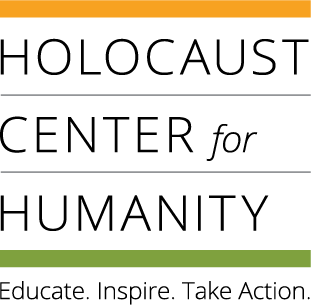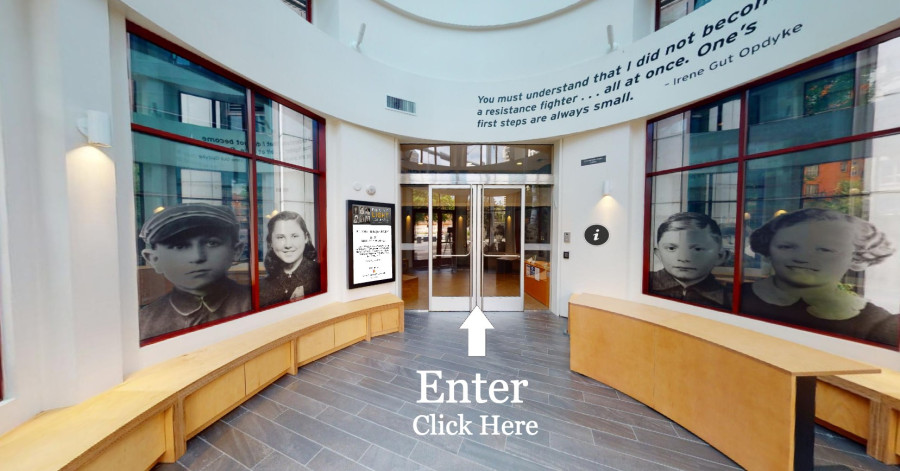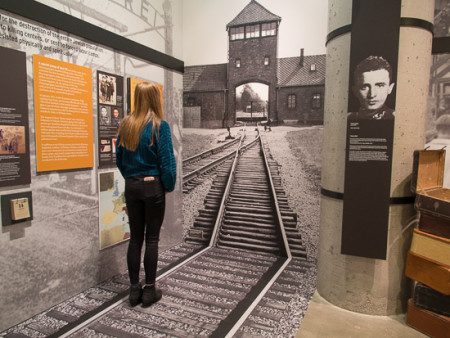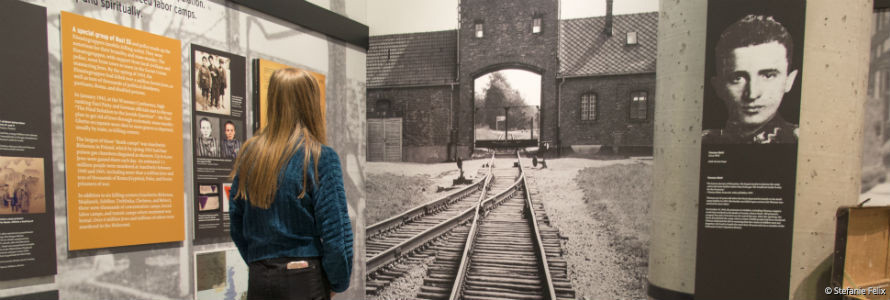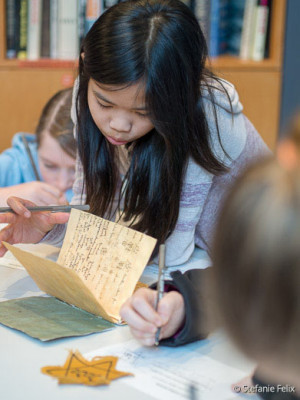In-Person Field Trip FAQs
Frequently Asked Questions
How much do field trips cost? In-person field trips have a flat fee of $175, which includes a $100 security charge. Please complete this form if you are interested in scholarships for admission fee or for bus transportation.
Who should attend a field trip? The Center's content and exhibit is tailored to students in grades 5-12 in Washington State and the Pacific Northwest. At this time, we are not scheduling field trips for schools/groups outside of the Northwest. Please visit the Association of Holocaust Organizations' (AHO) membership database to find a local center or museum near you.
Students should have previous knowledge of or lessons about the Holocaust; a field trip does not serve as the first introduction to the topic. The Holocaust Center will provide a guide and lessons to prep and debrief the experience. In addition, consider browsing our menu of Best Practices lesson plans for teaching this subject. If additional suggestions or resources are needed, just let us know!
How many students can you accommodate on a field trip? In-person, the Holocaust Center can accommodate field trips of up to 35 students. Have more students? We can often schedule multiple back-to-back groups at the Center, so ask us about this option! Numerous downtown Seattle attractions are nearby for group rotations. We suggest a student to chaperone ratio of 7:1. Teachers maintain the responsibility of managing their students at all times while in the museum.
How long is a field trip? In-person visits are a minimum of 90 minutes.
What do students do on a field trip? Teachers can pick from one of the two options below.
Option 1: Full Tour (90 mins) - Recommended for grades 9-12*
Our museum educators will guide students through a comprehensive, formal tour of our space, highlighting specific artifacts, photos, and videos.
*We recommend Option 1 for grade 9-12 students as we have observed that grade 5-8 students benefit from Option 2's more interactive format, but we will honor the teacher's choice either way.
Option 2: Tour + Activity (90 mins) - Recommended for grades 5-12
Museum educators will lead a condensed version of our full museum tour followed by an activity. Teachers, choose from the two activities listed below. We recommend this for all grade levels.
Teachers can choose from one of the following activities on their request form:
Exhibit Exploration Scavenger Hunt: Students will explore the exhibit individually using our guided worksheet to uncover artifacts, videos, and photos. After having time to explore, our museum educators will debrief with students to discuss more about what they learned.
OR
Explore & Share: Groups of 3-5 students will be assigned to specific areas of our exhibit. Guided by a group worksheet, they will read and reflect on the features of their specific area before sharing out to the class what they learned.
*Note: As of this year, field trips will no longer show our Survivor Voices film. We strongly encourage teachers to watch this 25-minute film in class as they prepare for the field trip, as it will familiarize your students with the Center and establish a baseline of knowledge that our museum educators will build from.
Can I add a speaker to my field trip? Absolutely. Teachers can choose to add a speaker presentation to their field trip experience. In this presentation, students will hear the personal story of a survivor or descendent of a survivor with opportunities for Q&A. To inquire, please indicate on your request form.
Adds an additional 60 mins to the field trip for a 2.5 hour experience
How far in advance do I need to schedule a field trip? We appreciate requests that are at least three weeks in advance -- but will make every effort to accommodate all requests.
What should teachers/students do to prepare? Once the field trip is scheduled, we will send you information to share with your students about expectations and making the most of an in-person field trip. As stated above, field trips will no longer show our Survivor Voices film, so we highly encourage teachers to watch this 25-minute film in class before the field trip. We will also provide post-field trip debrief suggestions.
What days are you available for field trips? Monday - Friday from 9am - 5pm. Some Sunday visits can be arranged, just let us know.
Can students eat lunch at the Holocaust Center? We do not have the facilities for students to eat lunch at the Holocaust Center.
What should teachers/students bring with them to the Holocaust Center? Students will not be able to bring backpacks/large bags inside – please leave at school or on the bus. Weapons of any kind, including pocket knives and pepper spray, are absolutely prohibited from entering the Center.
Virtual Field Trip FAQs
Frequently Asked Questions
How much do Virtual Field Trips (VFTs) cost? Virtual Field Trips are free for all schools and students.
Who should attend a VFT? The Center's content and exhibit is tailored to students in grades 5-12 in Washington State and the Pacific Northwest. At this time, we are not scheduling VFTs for schools/groups outside of the Northwest. Please visit the Association of Holocaust Organizations' (AHO) membership database to find a local center or museum near you.
Students should have some previous study of the Holocaust; a VFT does not serve as the first introduction to the topic. The Holocaust Center will provide a guide and lessons to prep and debrief the experience. In addition, consider browsing our menu of Best Practices lesson plans for teaching this subject. If additional suggestions or resources are needed, just let us know!
How many students can you accommodate in a VFT? We can accommodate any group size on a Virtual Field Trip via Zoom.
How long is a VFT? The virtual visit is a minimum of 45 minutes, which includes time for Q&A. Please allow for a few extra minutes at the beginning to set up the call and discuss any last minute considerations. If the class would like to dedicate more than the minimum 45 minutes, please use the request form to indicate the start and end of the full potential time slot (such as the start and end of the class period).
What happens in a VFT? Our Virtual Field Trips are designed to be interactive and engaging. Docents and a volunteer or staff member collaborate to present a multimedia experience within our new 3D, interactive scan of the Holocaust Center's exhibit "Finding Light in the Darkness." This VFT experience is immersive and feels as if you are truly inside the Center! It includes images, artifacts, videos, and more -- all primary sources from the Holocaust era. A special emphasis is made on local Washington State Holocaust survivors and their accounts, connecting the Holocaust to the world we live in today, and discussing what students can do to take positive action in their communities. There is always time for questions from students, as well as engagement within the chat.
How far in advance do I need to schedule a VFT? We appreciate requests that are at least three weeks in advance -- but will make every effort to accommodate all requests.
What should teachers/students do to prepare? Once the Virtual Field Trip is scheduled, we will send you information to share with your students about expectations, and making the most of a VFT. We will also provide post-field trip debrief suggestions.
What days are you available for VFTs? Monday - Friday from 9am - 5pm.
Finding Light in the Darkness - Exhibit
"I believe very strongly this is the most hopeful place in the city."
- Steve Adler, Local Holocaust Survivor
Finding Light in the Darkness - Through stories and artifacts of Washington State Holocaust survivors, the museum’s exhibit engages visitors in this history and challenges them to consider how each person’s actions make a difference.
Visitors can interact with video testimony from local Holocaust survivors, explore artifacts that bring history to life, and learn about local students who are upstanders in their schools and communities.
Explore Virtually - Enter Now
Special thanks to TPN for creating this interactive virtual exhibit.
Exhibit is on display at the Henry and Sandra Friedman Holocaust Center for Humanity, 2045 2nd Avenue, Seattle, WA 98121.
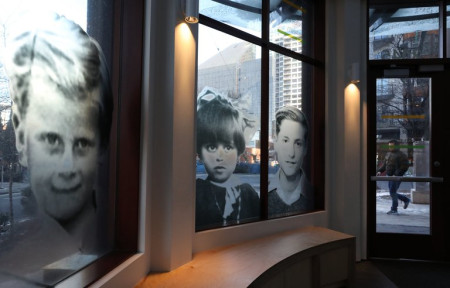
At the entrance to the Holocaust Center for Humanity are photos of children who experienced the Holocaust. All are survivors who later moved to the Seattle region, with the exception of one. Come visit and learn more about the stories. Photo by Alan Berner, Seattle Times staff photographer.
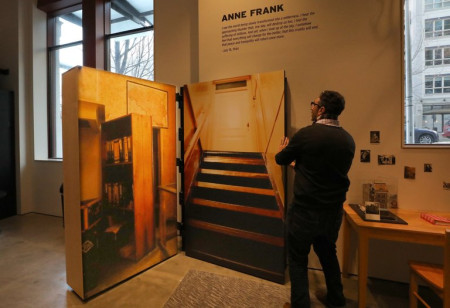
A bookcase opens to reveal a photograph of the stairs leading to Anne Frank's hiding place in Amsterdam during the Nazi occupation. Explore this feature and learn more about Anne Frank when you visit the Holocaust Center. Photo by Alan Berner, Seattle Times staff photographer.
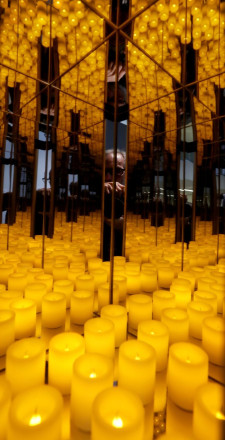
A memorial to the 6 million Jewish people murdered in the Holocaust and the millions of other victims invites visitors to leave notes, prayers and wishes at the Holocaust Center. Photo by Alan Berner, Seattle Times staff photographer.
Train tracks at the Auschwitz-Birkenau death camp in Poland at the Holocaust Center for Humanity. Designed by architects Olson Kundig. Photo by Stefanie Felix.
This exhibit was supported, in part, by 4Culture/King County Lodging Tax and The State of Washington.
The development and training of museum tour guides (docents) is made possible with the generous support of the Union Pacific Foundation.
Field Trips
Field Trips
Virtual Field Trips
Suggested for grades 5 and up. Minimum time commitment of 45 minutes. Free for all schools.
In this live virtual walk-through, our museum educators will highlight key stories, artifacts, images, and pivotal events featured in the Holocaust Center's 3D virtual exhibit, "Finding Light in the Darkness". Students will have the opportunity to see the museum without leaving their classroom and have their questions answered in real time by our museum educators. Teachers may have their students join on their own devices or project at the front of the classroom.
In-Person Field Trips
Minimum time commitment of 90 minutes. Accommodates up to 35 students per field trip. Flat fee of $175 per field trip with scholarship opportunities available.
Engage in the history of our local Holocaust survivors directly at our museum in downtown Seattle. In our in-person field trips, teachers can customize their students’ experience by choosing from a menu of activities that are facilitated by our passionate and knowledgeable team of museum educators.
Please review the options at the link below before filling out your request form.
View our “Designing your HCH Field Trip” guide here!
Note: If you are looking to bring an adult group into the museum (not a student group), please use our Adult Group Museum Tour Request Form instead.
FAQs & Policies
Please review our full FAQs & Policies for Virtual Field Trips or In-Person Field Trips before scheduling.
At this time, we are not scheduling field trips for schools/groups outside of the Northwest. Please visit the Association of Holocaust Organizations' (AHO) membership database to find a local center or museum near you.
Questions? Contact This email address is being protected from spambots. You need JavaScript enabled to view it..
Check out the many schools and groups that went on Virtual Field Trips to the Holocaust Center for Humanity in 2022-23!
Anne Frank Tree
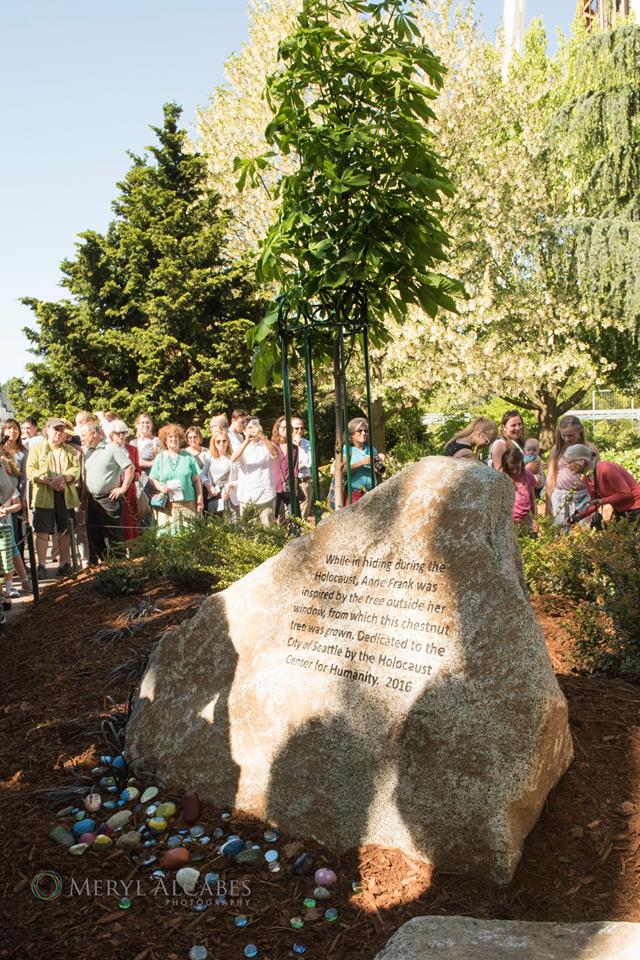 "Our chestnut tree is in full bloom. It's covered with leaves and is even more beautiful than last year." - Anne Frank, May 13, 1944
"Our chestnut tree is in full bloom. It's covered with leaves and is even more beautiful than last year." - Anne Frank, May 13, 1944
The Holocaust Center for Humanity is honored to have been selected to receive one of 11 Anne Frank Tree saplings to come to the United States. The tree is planted in the Peace Garden at the Seattle Center.
From her only window to the outside world, Anne Frank could see the sky, birds and a majestic chestnut tree. “As long as this exists,” Anne wrote in her diary, “how can I be sad?”
During the two years she spent in the Secret Annex, the solace Anne found in her chestnut tree provided a powerful contrast to the Holocaust unfolding beyond her attic window. And as war narrowed in on Anne and her family, her tree became a vivid reminder that a better world was possible.
Anne’s tree would outlive its namesake by more than 50 years, before being weakened by disease and succumbing to a windstorm in 2010. But today, thanks to dozens of saplings propagated in the months before its death, Anne’s tree lives on in cities and towns around the world.
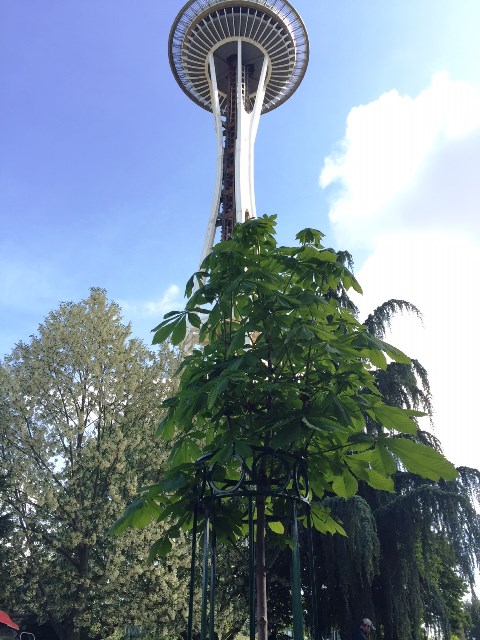 Here in the United States, the Sapling Project brought eleven of these precious trees to specially selected locations across the country. The Holocaust Center for Humanity is honored to have been selected to receive one of these saplings.
Here in the United States, the Sapling Project brought eleven of these precious trees to specially selected locations across the country. The Holocaust Center for Humanity is honored to have been selected to receive one of these saplings.
After years of special care from Seattle Parks and Recreation, the Anne Frank Tree was planted in the Seattle Center Peace Garden and dedicated to the city of Seattle on May 1, 2016.
